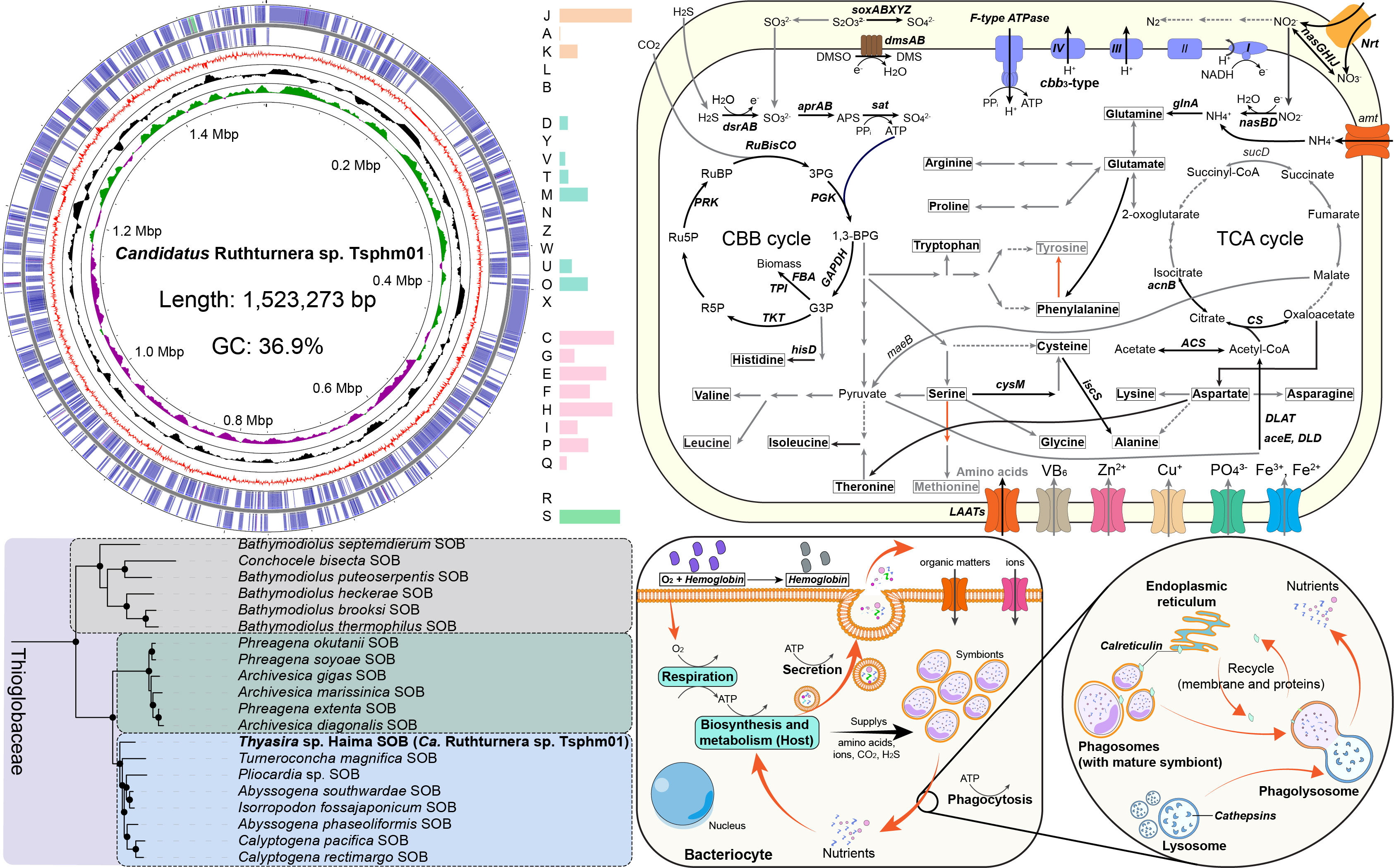Sitemap
A list of all the posts and pages found on the site. For you robots out there is an XML version available for digesting as well.
Pages
Posts
portfolio
The complete symbiont genome from a methane-seep thyasirid and the cooperated evolution in anoxic sediment (5th publication, Molecular Ecology Resources)
We report the first circular thyasirid symbiont genome, named Candidatus Ruthturnera sp. Tsphm01, with a size of 1.53 Mb, 1521 coding genes and 100% completeness. Compared to its free-living relatives, Ca. Ruthturnera sp. Tsphm01 genome is reduced, lacking components for chemotaxis, citric acid cycle and de novo biosynthesis of small molecules (e.g. amino acids and cofactors), indicating it is likely an obligate intracellular symbiont. Nevertheless, the symbiont retains complete genomic components of sulphur oxidation and assimilation of inorganic carbon, and these systems were highly and actively expressed. Moreover, the symbiont appears well-adapted to anoxic environment, including capable of anaerobic respiration (i.e. reductions of DMSO and nitrate) and possession of a low oxygen-adapted type of cytochrome c oxidase. Analysis of the host transcriptome revealed its metabolic complementarity to the incomplete metabolic pathways of the symbiont and the acquisition of nutrients from the symbiont via phagocytosis and exosome. 
The chromosomal evolution in Mollusca (6th publication, eLife)
We use synteny to study the karyotype diversity in Mollusca with four chromosome-level chiton genomes. With the constructed Mollusca Linkage Groups, we found that: 1) rearrangements in morphologically conservative Polyplacophora; 2) conserved syntenic matches in Venerida; 3) two different levels duplication events in Gastropoda (real sense of Whole Genome Duplication in Heterobranchia and approximate WGD in Ceanogastropoda); 4) ancient chromosome duplication or fission happend in Polyplacophora (Liolophura japonica) and two scaphopods; 5) still confusing events in Cephalopoda. 
publications
1st Molecular responses of an estuarine oyster to multiple metal contamination in Southern China revealed by RNA-seq
Published in Science of the Total Environment, 2019
Detail: Yunlong Li, Xinhui Zhang, Jie Meng, Jieming Chen, Xinxin You, Qiong Shi, Wen-Xiong Wang*. (2020). Science of the Total Environment. 701: 134648. doi: 10.1016/j.scitotenv.2019.134648
Download Paper
2nd Protein molecular responses of field-collected oysters Crassostrea hongkongensis with greatly varying Cu and Zn body burdens
Published in Aquatic Toxicology, 2021
Detail: Yunlong Li, Wen-Xiong Wang*. (2021). Aquatic Toxicology. 232: 105749. doi: 10.1016/j.aquatox.2021.105749
Download Paper
3rd Copper promoting oyster larval growth and settlement: Molecular insights from RNA-seq
Published in Science of the Total Environment, 2021
Detail: Yunlong Li, Karl Wah-Keung Tsim, Wen-Xiong Wang*. (2021). Science of the Total Environment. 784: 147159. doi: 10.1016/j.scitotenv.2021.147159
Download Paper
4th Integrated transcriptomics and proteomics revealed the distinct toxicological effects of multi-metal contamination on oysters
Published in Environmental Pollution, 2021
Detail: Yunlong Li, Wen-Xiong Wang*. (2021). Environmental Pollution. 284: 117533. doi: 10.1016/j.envpol.2021.117533
Download Paper
5th Reduced chemosymbiont genome in the methane seep thyasirid and the cooperated metabolisms in the holobiont under anaerobic sediment
Published in Molecular Ecology Resources, 2023
Detail: Yunlong Li#, Xing He#, Yuxuan Lin, Yi-Xuan Li, Gennady M. Kamenev, Jiying Li, Jian-Wen Qiu, Jin Sun*. (2023). Molecular Ecology Resources. 23:1853-1867. doi: 10.1111/1755-0998.13846
Download Paper
6th Still waters run deep: Large scale genome rearrangements in the evolution of morphologically conservative Polyplacophora
Published in eLife, 2024
Detail: Julia D. Sigwart#*, Yunlong Li#*, Zeyuan Chen, Katarzyna Vončina, Jin Sun*. (2024). eLife. 13:RP102542. doi: 10.7554/eLife.102542.1
Download Paper
7th (preprint) Shallow-water chemosymbiotic clams are a globally significant and previously overlooked carbon sink
Published in bioRxiv, 2024
Detail: Menggong Li#, Yunlong Li#, Shihai Mao#, Zhixin Zhang, Chong Chen, Xueying Nie, Xu Liu, Hui Wang, Xiaoshou Liu, Weipeng Zhang, Qiang Lin, Guang-Chao Zhuang*, Jin Sun* (2024). bioRxiv. doi: 10.1101/2024.02.25.581922v2
Download Paper
8th (preprint) Reliable inference of phylogenomic relationship via assembly-based strategy accommodating raw reads and proteins
Published in bioRxiv, 2024
Detail: Yunlong Li#*, Xu Liu#, Chong Chen, Jian-Wen Qiu, Kevin Kocot, Jin Sun*. (2024). bioRxiv. doi: 10.1101/2024.07.24.604968
Download Paper
9th (preprint) A multilamellar organelle for chemosymbiosis in an aplacophoran mollusc adapted to anoxic cold seep sediment
Published in bioRxiv, 2025
Detail: Yunlong Li#, Chong Chen#, Xu Liu, Menggong Li, Haiyun Zhou, Hui Wang, Xiaoshan Zheng, Xing He, Shanshan Liu, Jian-Wen Qiu*, Pei-Yuan Qian*, Jin Sun* (2025). bioRxiv. doi: 10.1101/2025.01.16.633305
Download Paper